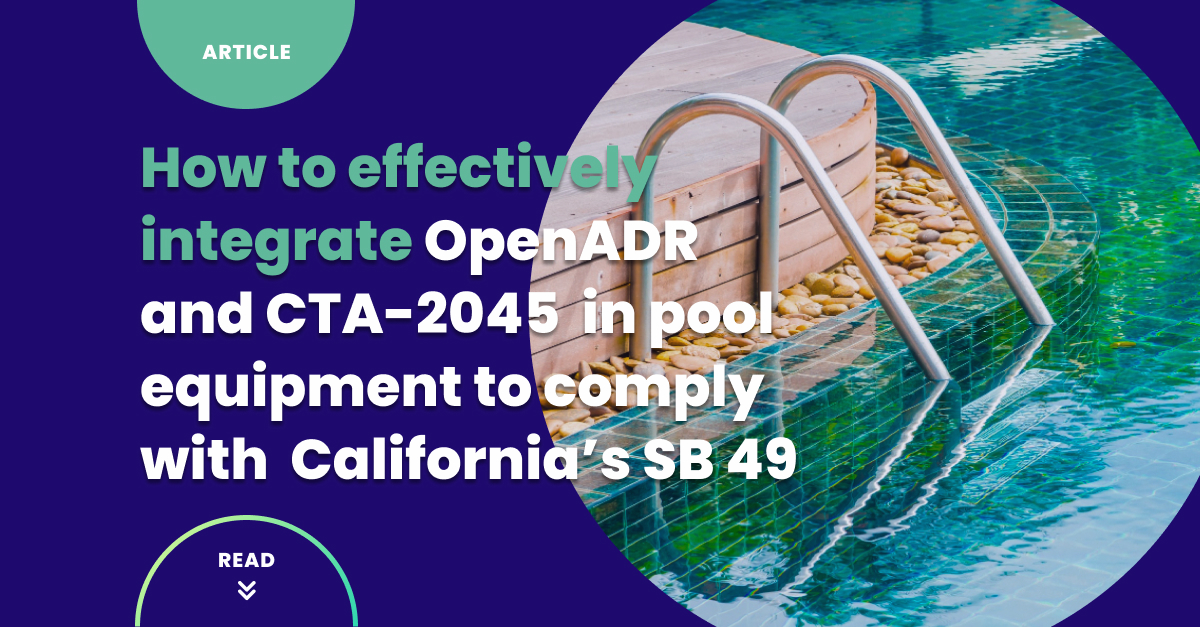How to effectively integrate OpenADR and CTA-2045 in pool equipment to comply with California SB 49

California’s Senate Bill 49 (SB 49), set to become effective in September 2025, represents a significant step forward for residential pool equipment manufacturers. The bill mandates that all pool equipment sold within California must support automated demand flexibility. Central to achieving this compliance is the implementation of one of a number of standards, where two stand out for ease of implementation and standardized application across the industry: OpenADR and CTA-2045. Successfully integrating one of these standards is key to meeting the new regulatory requirements, improving energy efficiency, and ensuring consumer satisfaction.
Why are OpenADR and CTA-2045 crucial for SB 49 compliance?
As mentioned in our previous article, OpenADR and CTA-2045 standards have become central elements in the landscape of flexible energy management. These protocols enable pool equipment, such as pumps and controllers, to communicate seamlessly with utility providers and dynamically respond to real-time electricity pricing and demand response signals. By doing so, pool equipment can effectively manage its operation, reducing energy usage during high-demand periods and optimizing operations to use energy when renewable resources like solar and wind are abundant. This responsiveness helps mitigate stress on the grid, reduces greenhouse gas emissions, and delivers cost savings to consumers.
OpenADR: real-time energy management
Here’s your expanded paragraph with the incorporated references to Codibly’s blog:
OpenADR is a globally recognized, standardized communication protocol designed specifically for automated demand response. It allows utilities to communicate real-time energy prices and grid events directly to connected appliances. When a pool control system incorporates OpenADR, it can automatically adjust its energy consumption based on utility-generated signals, optimizing energy use and reducing the load during peak demand periods. For instance, a pool pump equipped with OpenADR technology can automatically shift its operation to midday when solar energy production peaks, significantly reducing reliance on more costly, carbon-intensive energy sources. At Codibly, we’ve extensively discussed OpenADR in our blog, providing detailed insights and practical advice. For instance, we’ve covered topics like OpenADR’s role in energy certification and explored best practices for implementing OpenADR standards effectively. These resources can provide you with guidance to smoothly integrate this essential technology.
Detailed documentation and technical specifications for OpenADR can be found on the OpenADR Alliance website.
The role of CTA-2045: simplifying hardware connectivity
CTA-2045 complements OpenADR by offering a standardized hardware interface that enables appliances to easily connect to various demand response communication networks. Often referred to as a universal communication module, CTA-2045 allows pool equipment to seamlessly integrate with multiple utility demand response systems without extensive hardware redesigns. It provides a physical interface specification, enabling simple “plug-and-play” capability, significantly reducing development complexity and accelerating product compliance timelines.
Comprehensive resources, specifications, and documentation on CTA-2045 standards are available on the CTA Technology Standards website.
Step-by-step integration for pool equipment manufacturers
Successfully integrating OpenADR and CTA-2045 standards involves a structured, step-by-step process:
Step 1: Comprehensive technical assessment
Begin by thoroughly assessing your existing product lines against SB 49’s specific requirements outlined by the California Energy Commission (CEC). Identify clear gaps and areas that need upgrading or redesign to meet SB 49’s flexible demand appliance standards.
Step 2: Choosing the right technology partners
Selecting reliable technology partners or vendors with proven experience in OpenADR and CTA-2045 integration can significantly streamline this complex technical transition. Expert providers offer validated and tested modules and solutions, ensuring robust compliance without extensive internal development efforts. This collaboration reduces risk, accelerates timelines, and enhances the overall quality of the final product.
Step 3: Prototyping and comprehensive testing
Develop detailed prototypes incorporating both OpenADR and CTA-2045 standards. Conduct thorough testing in certified laboratories recognized by the California Energy Commission. Early identification of issues through rigorous testing ensures reliability, reduces market entry risk, and guarantees product performance aligns precisely with regulatory requirements.
Detailed testing and certification guidelines can be accessed through the CEC’s Appliance Efficiency Certification portal.
Step 4: Certification and regulatory validation
After successful testing, secure formal product certification from the CEC. This certification process confirms that your products fully comply with SB 49, meeting all technical specifications, including automated scheduling capabilities, communication reliability, and cybersecurity protocols designed to protect consumer data.
Completing certification promptly ensures your products enter the California market efficiently, without costly delays.
Step 5: User-friendly design and clear communication
While technical compliance is essential, consumer adoption of new ADR technologies hinges on user experience. Equip your products with intuitive interfaces and clear, informative documentation that explains the demand response process in accessible language. Consumers should understand precisely how and why their pool equipment operates differently under SB 49, appreciating both the environmental benefits and personal cost savings associated with flexible demand management.
Learning from industry case studies
Real-world examples demonstrate the viability and advantages of integrating OpenADR and CTA-2045 standards. For instance, testing conducted by the National Renewable Energy Laboratory (NREL) found variable-speed pool pumps embedded with CTA-2045 responded reliably to demand response signals. These pumps shifted their energy consumption effectively to off-peak times, significantly reducing grid strain and energy costs without sacrificing consumer convenience or equipment performance.
Strategic recommendations for manufacturers
Manufacturers looking to streamline compliance processes may benefit significantly from leveraging industry expertise. Collaborating with experienced technical partners familiar with OpenADR and CTA-2045 integration ensures a smoother, more cost-effective path to SB 49 compliance. It allows your business to stay focused on core competencies, minimizes disruptions, and accelerates the delivery of compliant, market-ready products.
Integrating OpenADR and CTA-2045 standards into pool equipment is essential to successfully navigating SB 49 compliance. By proactively following the structured approach outlined here, manufacturers can not only meet California’s rigorous new regulations but also position themselves as leaders in a rapidly evolving market driven by sustainability, innovation, and consumer demand for smarter, cleaner energy solutions.
contact us
Preparing for California’s Senate Bill 49?
Connect with Codibly’s specialists to simplify your path to compliance with California’s SB 49 by September 2025.
